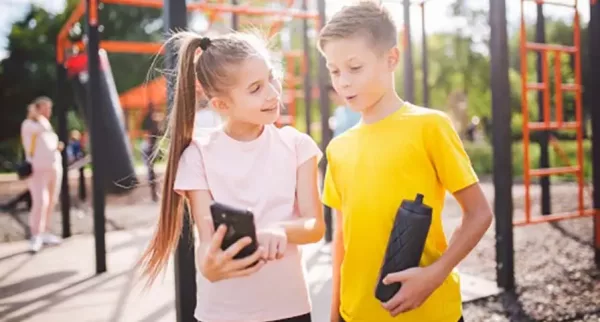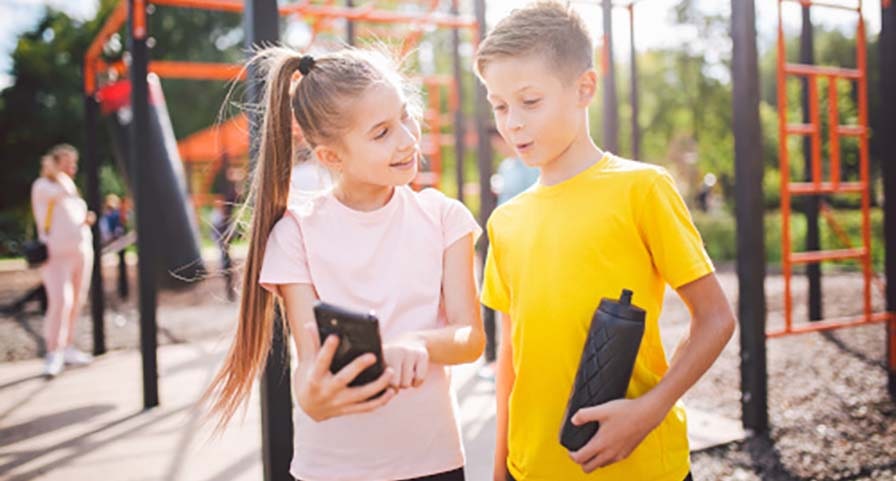Originally published July 21, 2022 by eSchoolNews.
By Ismail Karon
The days of rolling the ball out and playing sports in PE are changing.
With the advancement of technology and shift towards collaborative work in the classroom, physical education teachers are finding more and more ways to keep PE relevant in the collaborative and technology-filled 21st century.
 Project-based learning
Project-based learning
Project-based learning is a type of instruction that emphasizes collaborative work, real world connections and a deeper understanding of content. Students are placed in groups and given a goal or project to complete. In their teams they assign roles, and divide work. Students are expected to research their project, plan out their learning, deal with any issues that arise, and present their findings.
Project-based learning places the majority of the responsibility of learning on the students. Within the physical education classroom, combining project-based learning with technology will ensure that students become 21st-century learners. Physical education teachers can implement project-based learning to encourage the use of different technologies, practicing collaboration, and problem solving.
Wearable technology
As technology has advanced, the opportunities to utilize new gadgets in the classroom has increased. These days, there are many different tools that gauge heart rate, steps, running pace, type of exercise, calories burned, and much more. Physical education teachers can use wearable technology in the classroom to give students an immediate and accurate look at their own activity stats in connection with their physical fitness lessons.
Wearable technology has gone beyond the traditional pedometer. Newer technology allows students to track their exercise intensity, calories burned, oxygen levels, etc. These gadgets connect to applications on phones and tablets to store and display data. Students are able to go back and look at their overall stats in order to analyze and find a deeper understanding of their own physical fitness and the effects different types of movement and activity have on their body.
By using wearable technology, students can begin to connect the feeling of the physical benefits of exercise and the impact the activity has on their bodies. As an added collaborative bonus, wearable technology give students the ability to share their data, compare, and compete with others.
Flipped classroom
The flipped classroom gives teachers the ability to instruct students virtually before a lesson, so the time spent in class can be used for application and engagement rather than initial learning or lecture. The teacher can create the lesson, including visuals, graphics, digital resource materials, and formative assessments that students complete prior to the in person lesson. This encourages students to learn in different ways and at their own pace. They are able to go back through the digital lesson and review and slow down anything they do not initially understand. This way, when they get to class, they are prepared with questions and are ready to apply their new knowledge to the lesson. In person, students are then able to collaboratively practice what they have learned together.
Flipped lessons also allow students to ask their questions in person while they attempt to apply their new knowledge. It encourages students to learn, fail, ask questions, critically think, and understand more fully.
Benefits from technology in PE class
Physical education teachers are finding all sorts of ways to keep PE relevant and ensure students are practicing their 21st-century skills in class.
The main focus of PE continues to rely upon fitness, skill development, and strategy etc. However, teachers need ways to keep the 21st-century student engaged while learning. Today’s students have grown up with technology at their fingertips constantly. The best way to keep them engaged in class is to speak their language and to include technologies and strategies that keep them connected.
Project-based learning is a teaching strategy that gives the learning responsibility to the student, urging them to collaborate and problem solve all while working with technology. Wearable technology gives students the ability to understand how their physical movements connect with their overall physical fitness in real time, while being able to collaborate and compete with others. The flipped lesson benefits students in physical education by minimizing lecture time in the classroom and maximizes action and engagement. By front loading-content before class, students can come to class with a working knowledge of what is needed or expected.
Ismail Karon is a physical education teacher who has taught at each level throughout K-12.
Make the IHT ZONE heart rate monitor part of your School's Student Wellness Program




